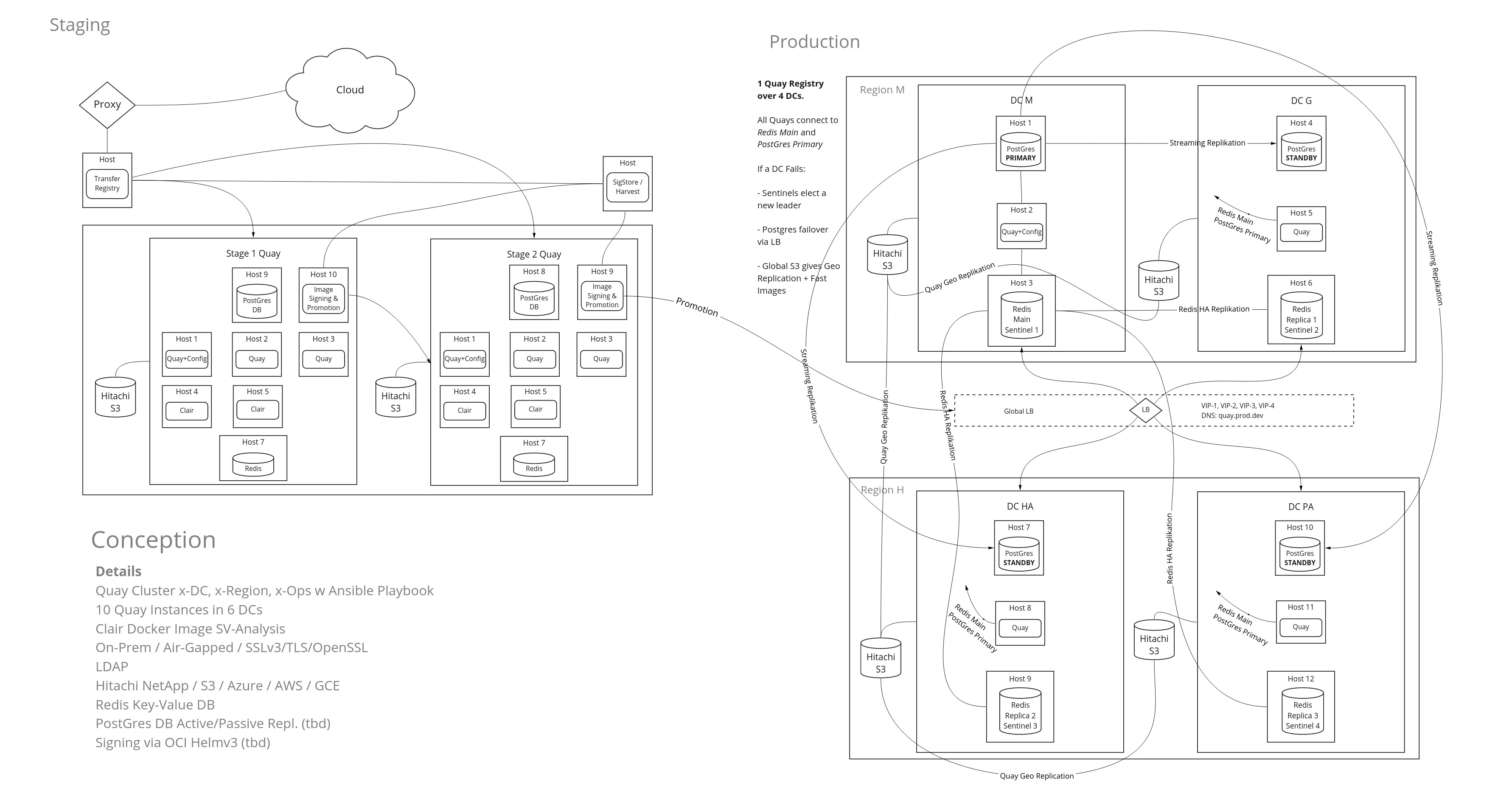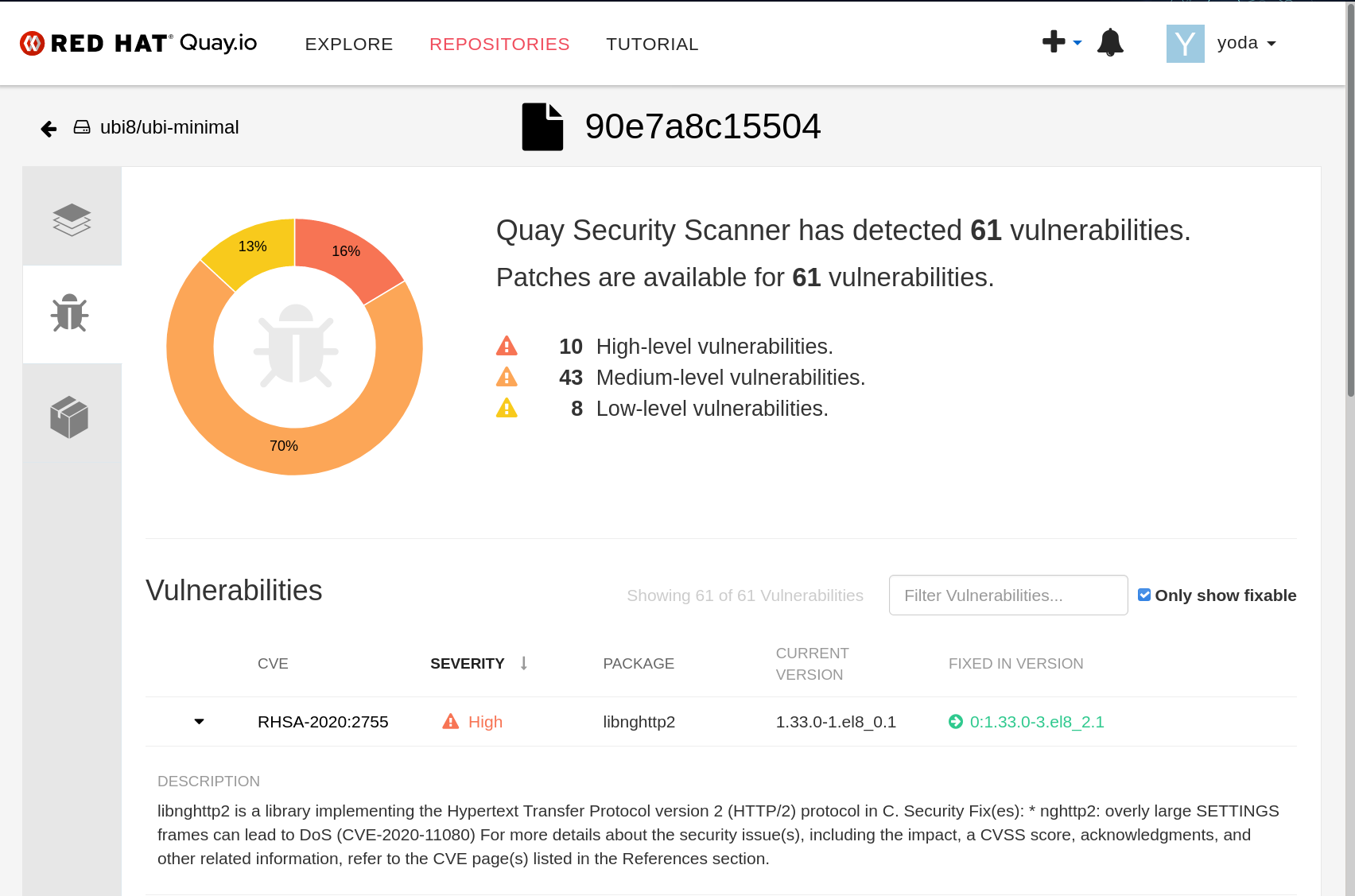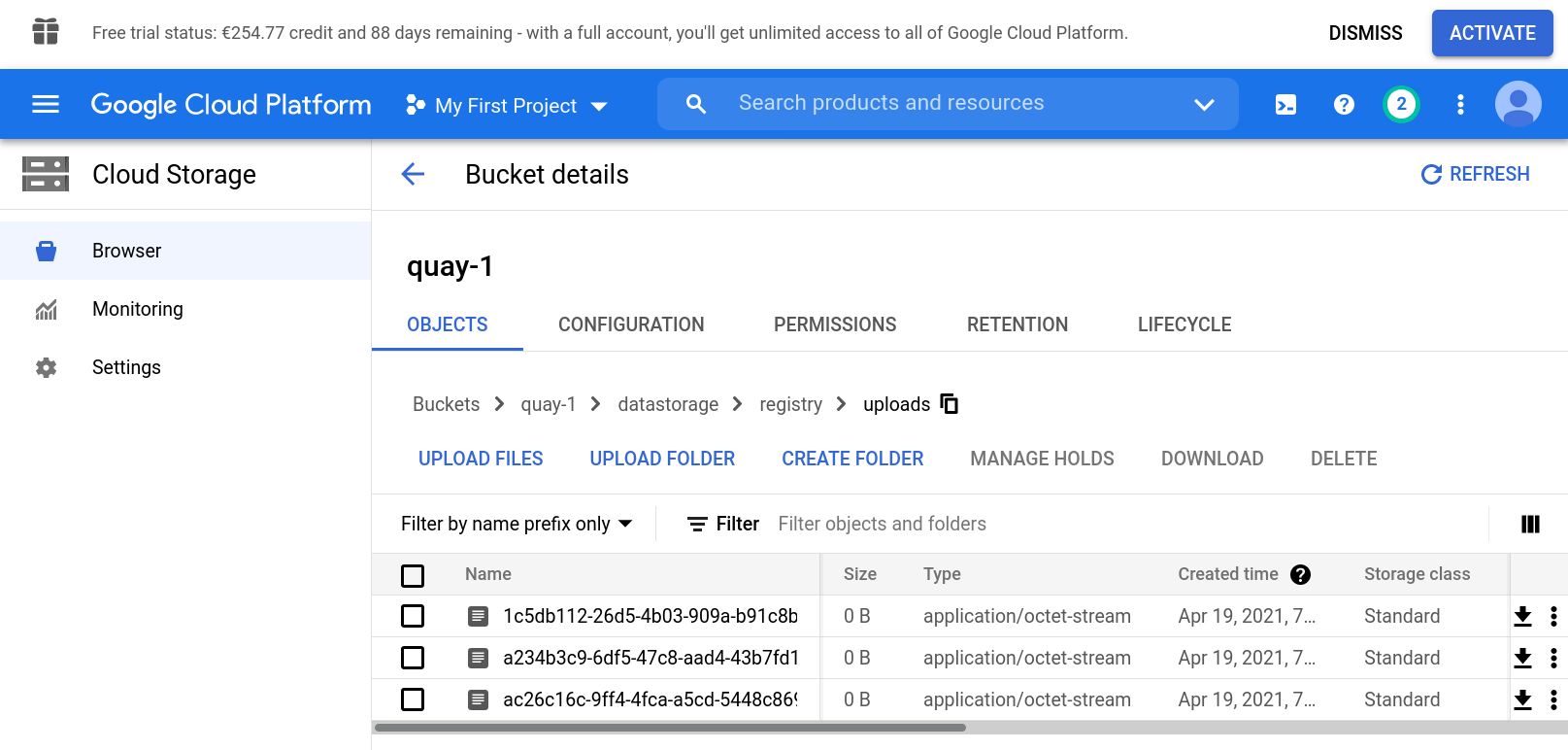These playbooks can be used to setup Quay 3.3.4 and Clair 3.3.4 in an HA configuration following the docs here.
- RHEL 8.x VMs with podman installed.
- DNS records or Load-Balancer Setup for multiple Quay instances, multiple Clair instances, Redis and Postgres
- Certificates and Private Keys for Quay and Clair and CA certificates. These are provided pre-signed for a local .dev domain in the inventory.
- Expects firewalld and SeLinux to be enabled and firewall opened for ports 8443 for config_mode, 443 for quay, 5432 for Postgres, 6379 for Redis, 6060 and 6061 for Clair. 6062 and 6063 are used internally by Clair.
- S3 storage
- Tested on RHEL 8.2 with Ansible 2.9.16
- Will install Quay, Clair, Redis and Postgresql DB for Quay, Clair and Redis
- Consult the Quay Enterprise 3.x Tested Integrations KB Article.
- Create 4 or more VMs. 4 would run the cluster minimum (unsupported). 6 or more would an ideal setup for start with HA (supported).
- Adapt the inventory or adapt
ansible.cfgto your inventory - Replace all certs or use given ones if you have the same domain
- Run
ansible-playbook p_setup-all.yml - Consider running the included Smoke Test Suite
- Version increments are n-1. This means subsequent updates have to be done in order to get to the latest version.
- For this you can either alter these playbook's config mode part or do a container-by-container update strategy as described here.
- Make modifications for your environment in the inventory files. This inventory files try to serve as single source of truth, in order to maximize compatibility of these playbooks with Ansible Tower.
- Most Quay options start with
clair_orquay_. - Secrets and certs are stored in group_vars/all.yml and are encrypted.
- Mark individual hosts with is_quay=true and is_clair=true to run those components on the respective hosts.
- Review
roles/quay/defaults/main.ymlfor default variable values and options and feel free to move more parameters to the inventory - The pre-provided Certificates are non-SAN, self-signed and valid for local .dev domain. The Vault PW is in the inventory.
Quay Config is split into
config.yaml
roles/quay/files
├── quay
│ └── config.yamlquay.yml
inventories/dev/
├── group_vars
│ └── quay.ymlThis are two important files, which you most certainly want to change. This file is built in layers by the Playbooks.
- Config object response from quay config mode API
- Reuse of DATABASE_SECRET_KEY from first found existing config.yaml on re-run
- Some sane defaults from
roles/quay/files/quay/config.yaml - Values from 'quay_config' variable defined in inventory.
Quay's resulting config.yaml file is where everything gets merged into and validated in config mode of the playbooks.
...
FEATURE_STORAGE_REPLICATION: true
DISTRIBUTED_STORAGE_CONFIG:
default:
- AzureStorage
- azure_account_key: "{{ secrets.secret_key }}"
azure_account_name: quaystorageaccount
azure_container: quayblobstorage
sas_token: "{{ secrets.secret_key }}"
storage_path: /datastorage/registry
DISTRIBUTED_STORAGE_DEFAULT_LOCATIONS:
- westeurope
...If LDAP is used, AUTHENTICATION_TYPE must be set to LDAP and SUPER_USERS variable must contain the list of LDAP users which will have admin permissions.
SUPER_USERS: [user1, user2, user3]
...
AUTHENTICATION_TYPE: LDAP
LDAP_ADMIN_DN: uid=admin,cn=users,cn=accounts,dc=shared,dc=example,dc=opentlc,dc=com
LDAP_ADMIN_PASSWD: "{{ secrets.ldap_password }}"
LDAP_BASE_DN:
- cn=accounts
- dc=shared
- dc=example
- dc=opentlc
- dc=com
LDAP_EMAIL_ATTR: mail
LDAP_UID_ATTR: uid
LDAP_URI: ldap://ipa.shared.example.opentlc.com
LDAP_USER_RDN:
- cn=users
LDAP_SECONDARY_USER_RDNS:
- cn=users2
FEATURE_TEAM_SYNCING: true
TEAM_RESYNC_STALE_TIME: 1m
...roles/quay/files
├── clair
│ └── config.yamlThis is an important file in addition to the inventory. Security Scanner options are gathered either by
- Re-use of
security_scanner.pemfile and ID if already present on all clair hosts and known by the Quay config API responses - New Key by Quay Config API generating a key
In the Clair config.yaml file you can change default ports or certificate and SSL options.
verifier_proxies:
- enabled: true
# The port at which Clair will listen.
listen_addr: :6060
# If Clair is to be served via TLS, uncomment these lines. See the "Running Clair under TLS"
# section below for more information.
key_file: /clair/config/ssl.key
crt_file: /clair/config/ssl.crt
..The Inventory contains a hosts file and group_vars directory with quay, redis, postgres files for the according host groups. All certificates and private keys are stored in the inventory.
inventories/
└── your.domainname
├── group_vars
│ ├── all.yml
│ ├── local.yml
│ ├── postgres.yml
│ ├── quay.yml
│ └── redis.yml
└── hostsdrop_quay_db: true
delete_old_quay_config: true
remove_all_folders: true
remove_redis_container: true
remove_quay_container: true
...
quay_db_admin_username: postgres
quay_redis_port: 6379
quay_db_password: "{{ secrets.quay_db_password }}"
postgres_ssl_crt: "{{ certs.postgres_ssl_crt }}"
secrets:
quay_db_password: !vault |
...
certs:
postgres_ssl_crt: !vault |
...The all.yml file is where all the secrets and certificates and most of the variables are defined.
quay_config:
# Merged on top of default API config + Role config file
# See: # https://access.redhat.com/documentation/en-us/red_hat_quay/3/html/manage_red_hat_quay/quay-schema
SUPER_USERS: [ yoda ]
DB_URI: "postgresql://{{ quay_db_username | urlencode }}:{{ quay_db_password | urlencode }}@{{ quay_db_hostname }}:{{ quay_db_port }}/{{ quay_db_dbname }}"
# GCE
#
DISTRIBUTED_STORAGE_CONFIG:
default:
- GoogleCloudStorage
- {
storage_path: /datastorage/registry,
access_key: accesskey,
secret_key: "supersecretkey",
bucket_name: quay-1
}
DISTRIBUTED_STORAGE_DEFAULT_LOCATIONS: [europe-west6]
DISTRIBUTED_STORAGE_PREFERENCE: [default]
DEFAULT_TAG_EXPIRATION: 4w
...[postgres]
postgres.dev
[postgres:vars]
postgres_runtime_user=postgres
[redis]
redis.dev
[redis:vars]
redis_runtime_user=redis
[quayconfig]
quay.dev is_quay=true
[quay]
quay.dev is_quay=true
quay-ha.dev is_quay=true
clair.dev is_clair=true
[all:vars]
redis_vm_user=user
postgres_vm_user=user
quay_vm_user=user
...roles/quay/
├── defaults
│ └── main.ymlThe quay role also contain defaults where variables such as setup client can be changed, e.g.:
...
quay_setup_client: "{{ groups['quayconfig'][0] }}"
...It is helpful to visualise the flow of the playbooks, e.g. the p_setup-all.yml playbook:
p_setup-quay-ha.yml
Setup Quay runtime user
Setup Clair runtime user
r_role/main.yml
r_role/database.yml
Setup postgres
Quay db
Quay user
Clair db
Clair db user
Extensions
Quay DB SSL Mode
Clair DB SSL Mode
Quay Directories
Repomirror Directories
Clair Directories
SeLinux
Copy Certs
Unit Tests
r_role/setup.yml
r_role/Container-quayconfig.yml
Run Container
Copy DB CA File
Quay Config
Config Validate
Remove Config Container
Copy Quay Config
Repomirror Config
Copy Quay Certificates
Clair Copy
Clair Key File
r_role/unit-test-clair.yml
r_role/container-quay.yml
Remove Old Container
Run Quay
Daemonize Quay
Unit Test Service
Run Repomirror
Run Container Quayconfig
Daemonize Quay Repomirror
Unit Test Service Repomirror
r_role/container-clair.yml
Remove old container
Run clair
Daemonize clair
Unit test serviceThen next, you could run p_smoke_test.yml playbook to verify the success of your installation.
-
Create Organisation, e.g.
ubi8in your deployed Quay User Interface -
Create aprivate Repository, e.g.
ubi-minimal -
Create the Robot "test_robot" in the Quay UI by clicking on the hog wheel icon on the left hand side and then the drop down arrow and after creation make sure full robot+name is linked with full admin permissions to the repository you just created
-
Get the Robot Token by clicking on the name of your test robot which is underlined. Again, link the robot token to the playbook's all.yml group file of your inventory, var name is
quay_test_robot_password. -
Create Oauth Application and Token in quay's angular ui. For that you click on Organisational View and then the Applications Icon on the left hand side. You can name the app anything you prefer, e.g.
test_app. -
Click on the Underlined App Name, then on Generate Token icon, which looks like a little cinema ticket. There you give the following minimal right: Create Repo, View Repo, R/W Repo, Read User. Click authorize green button. Copy the token.
-
Provide the Token in Playbooks
all.yml. The variable name is:quay_system_test_bearer -
Provide the test_image in your root-registry or locally. If locally, set host variable
test_skip_login_pull=true. Link it fromgroup_vars/all.yml, e.g.quay.dev/org/ubi-minimal:8.0 -
Run
p_smoke_testPlaybook, this will trigger all Integration and all Systems Tests towards your new Quay. -
System Tests are predestined to fail in the first run, this is to be expected. It won't find the Image ID. After successful failure of the test, you'll need get the Manifest ID from the test-automation pushed Image. Quay Ui Hint: Click on your Test-Repo, then on tags, then click on SHA256 in Manifest Column to get the content addressable SHA from the PopUp. Then reference it in
group_vars/all.ymlin thequay_system_test_manifestvariable. -
Run
p_smoke_testPlaybook again, it should test all System Tests and should test your whole Quay Cluster.
Quay Ansible Playbooks are under the GPLv3 License. See the LICENSE file for details.
Implemented by Stephan Kristyn and James Cole. These Playbooks are not supported by Red Hat.


